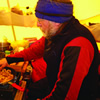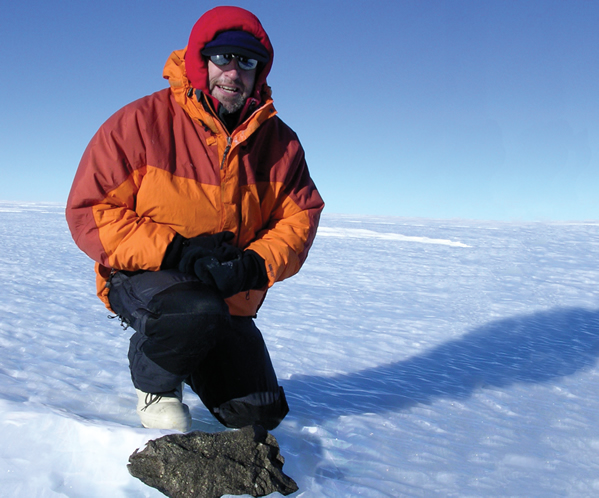Sunlight glints off a brilliant blue-white Antarctic glacier, and a frigid wind sends snow dust whirling. Eight yellow snowmobiles, 25 to 50 yards apart in a long line, advance in parallel at the pace of a brisk trot. Their drivers—all wearing mirrored wraparound goggles to protect their eyes from snow blindness—intently scan the ice for stones and pebbles, even ones as small as a thimble.
"Whoa, what's that?" exclaims Ralph P. Harvey, pointing to a fist-sized black rock lying half-buried in the ice all by itself. Halting his snowmobile and shutting off its engine, Harvey treks over to take a closer look. Smooth rounded edges, black shiny crust—sure enough, the rock is not a terrestrial stone, but a meteorite that plunged through the atmosphere from outer space.
Harvey begins jumping and waving his arms to attract his colleagues' attention. An astrogeologist in bulky parka and mittens at the bottom of the world, he is doing what he calls "the happy meteorite dance" to signal another celestial find.
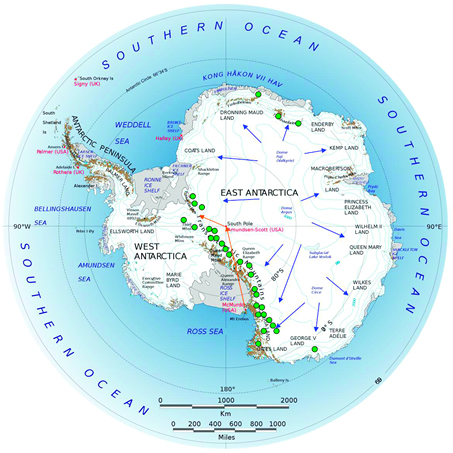
Since 1991, Harvey, an associate professor of geological sciences, has run the Antarctic Search for Meteorites (ANSMET), a 35-year-old project funded by the National Science Foundation. "I lead scientific parties to pick up space rocks lying on Antarctic ice sheets," Harvey explains. "It's a pretty fun Easter egg hunt—but one with immense scientific value."
A Polar Desert
Space dust, sand and gravel fall into the earth's atmosphere all the time. Doubtless you have seen it happen yourself—a sudden streak of light flashing across the night sky. Such "shooting stars" are pea-sized bits of space grit speeding into the upper atmosphere at maybe 25 miles per second, their collisions with air molecules heating them enough to vaporize their substance in a last glow of silent beauty. An estimated 40,000 tons of interplanetary debris fall into the earth's atmosphere every year. Most of the billions of particles burn up harmlessly miles overhead.
Meteorites are larger chunks that survived their fiery plunge all the way to the earth. But most of them are lost: They sink to the bottom of oceans or lakes, or are buried in sand dunes or soft soil, hidden by vegetation or eroded away by running water.
Except in Antarctica. "If you want to find dark rocks that have fallen from the sky, what better place to look than on a big white sheet 3,000 miles across?" says Harvey, referring to the vast diameter of the ice-covered continent.
Although meteorites are scattered here and there all over Antarctica, rich lodes may be found along the base of mountain ranges facing the interior. Why?
The center of the continent, near the South Pole, is several thousand feet higher than the coastline. Glaciers a mile or two thick cover much of its surface. These walls of ice flow from the central elevations outward and downhill to the coasts, carrying along any meteorites they have collected. In the east, this flow is eventually blocked by the Transantarctic Mountains, whose rocky projections trap and anchor some of the glaciers' edges. Over millions of years, the glacial ice accumulates in bays and pockets between the mountains, and the older ice is compressed until it attains a sky-blue color.
Under these conditions, you might think that the meteorites would be buried deep in the ancient ice. But the continent's abrasive winds expose them. "Antarctica is a polar desert," Harvey explains. The wind is so drying that it scours away ice, gradually revealing any meteorites embedded there.
Blue-ice regions, then, have unusual concentrations of meteorites. "This year, we worked one tiny area at Davis Nunataks that was just three by five kilometers—about two by three miles," Harvey recalls. "In one area the size of a tennis court, we found 30 to 40 meteorites."
A Hardy Band
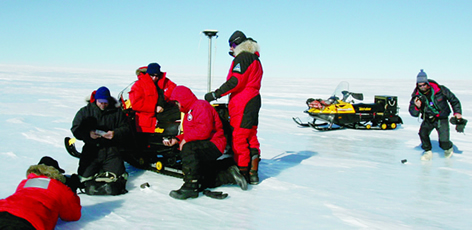
Each ANSMET expedition numbers from six to a dozen people, hand-picked by Harvey. The members range from university geologists to high school science teachers, all volunteering their time for a season. The only paid staff who return every year are Harvey himself, postdoctoral research associate James Karner (who serves as a second science lead at times when the expedition breaks into two field teams) and two professional mountain guides responsible for the expedition's safety: John Schutt and Shaun Norman.
Harvey calls each ANSMET expedition a "hardy band of earth astronauts." Indeed, parallels to the Apollo expeditions to the moon are striking. The Antarctic meteorite hunters venture into a harsh and dangerous land of magnificent desolation, far from emergency medical facilities. They wear protective gear (insulated parkas, boots and mittens) and haul everything they need for survival. Communication is limited—from the glacier, satellite phone and Internet access is at the 1980s rate of 2400 baud. And like the Apollo astronauts, the meteorite hunters are gathering rocks from outer space.
Since there are no direct flights from North America to Antarctica, the ANSMET volunteers must first fly from the United States to New Zealand, and then take a military plane another 2,400 miles due south to McMurdo Station, the largest of three permanent settlements on the continent. They make the trip in late November, as the Antarctic spring is warming toward summer.
Once the volunteers arrive at McMurdo, they select provisions and prepare their equipment, which includes tents able to withstand winds in excess of 100 miles per hour. For people heading out into remote isolation for six weeks, in a place where the average summer temperature hovers below 0°F, "food is very important, not just for fuel, but also for warmth and morale," Harvey says. "So we take food that makes people happy—including such delicacies as steak, shrimp, and chocolate—so they can look forward to cooking themselves a nice dinner each evening in camp." This past season, one ambitious scientist, Ryan Zeigler from Washington University, took a small propane oven and roasted a whole turkey for the group on Christmas.
At McMurdo, the ANSMET volunteers also go through astronaut-like survival school: rigorous safety training in first aid and rescue techniques, including how to climb a rope out of an ice crevasse (a precaution that, thanks to alert mountain guides, has never been needed in the field). During a shakedown 24-hour campout on the ice, everyone practices pitching and striking two-person, double-walled tents and lighting and cooking over propane stoves. Everyone also "takes driver's ed," Harvey says, learning how to pilot a snowmobile towing a sledge laden with 1,000 pounds of equipment, food and fuel.
By the end of the first week in December, the expedition begins. While some search sites have been as close as 150 miles from McMurdo Station, this past season the expedition ventured more than 1,000 miles distant. The members divided into two field teams. The main team, dedicated to systematic searching, went to the Davis-Ward ice fields in the Dominion Range, at the head of the Beardmore Glacier. There, eight earth astronauts set up a snug camp: their home-sweet-home for the next month and a half. Meanwhile, a highly mobile four-person reconnaissance team, dedicated to scouting possible future sites for collecting meteorites, was flown to the LaPaz Icefields and then to the Patuxent Range Icefields.
A Day on the Glacier
Since the midnight sun is up 24/7 in the Antarctic summer, the volunteers' lives are regulated entirely by their clocks, all set to McMurdo time. "There's no camp reveille, but we ask everyone to be out of their tents ready to go, mittens on, snowmobiles warmed up, by 9 a.m.," says Harvey. After their journey to the day's search site, the snowmobiles line up and "begin a traverse," slowly driving in parallel over the ice.
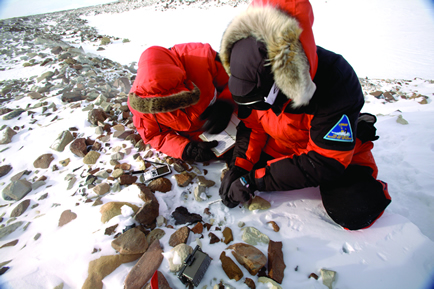
Whenever a field party member spots a dark dot of any size, he or she stops and gets out for a closer look. If it's a meteorite, the finder waves to attract the rest of the team. They photograph the find, determine its position with a GPS receiver, assign it a field number, pick it up with tongs and place it in a sterile Teflon bag that seals out contamination. On an average eight-hour day, a team might find two or three dozen meteorites—more than most meteorite hunters elsewhere discover in a lifetime.
Sometimes the search area is not smooth glacial ice, but instead a field of small, wind-blown terrestrial stones or even a moraine of larger terrestrial rocks. The team traverses these landscapes on foot.
The meteorites stand out from their surroundings. Whereas the terrestrial rocks may be reddish with rough edges (there is no flowing water to smooth them), meteorites have a blackened, rounded surface. "That's the fusion crust, where the outer layer of the rock was heated to melting as it plunged through the atmosphere," Harvey explains. Other clues are more subtle. For example, meteorites tend to be more fine-grained than terrestrial rocks, so they sparkle less in the sun.
"Perhaps the most important feature is just being 'different,'" Harvey says. "Field party members quickly become familiar with local rocks and learn to focus on anything out of the ordinary they may encounter—whether it's size, shape or color that catches their eye."
In sunny and calm conditions, the team may search an entire day. But Antarctica is the windiest place on Earth, with summer wind chills down to a brutal -40°F in the continent's interior, where the meteorite hunters work. "If it's cold and nasty, we may work only two or three hours," Harvey says. Weather eliminates three or four days each week: "It's just the price we pay."
Nothing Older
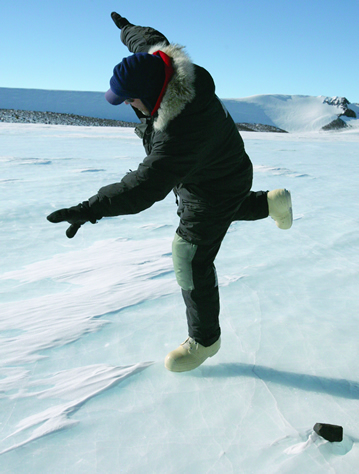
The hunt for meteorites, like much of science, "is a search for the origins of things," Harvey reflects. "Meteorites date back to when our solar system formed—there is nothing older in the solar system. And they are delivered to us right here on Earth, free of charge."
Before the ANSMET program began in 1976, the world's collection of meteorites numbered perhaps 1,800 to 2,000—a rather limited sample of the entire solar system. But in the past 35 years, ANSMET has returned nearly 20,000 meteorites from Antarctica, greatly expanding the range of materials known from outside the Earth. The 2010–2011 expedition alone returned 1,235 specimens.
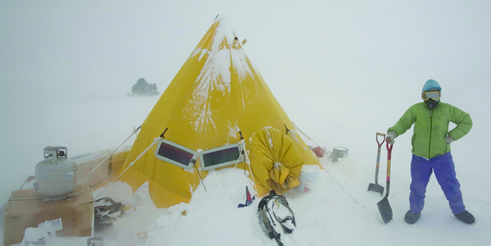
Almost all (99.5 percent) of meteorites come from the asteroid belt between Mars and Jupiter. One of ANSMET's major contributions has been to return many samples of a class of meteorites which chemical analysis suggests originated on 4 Vesta, the second-largest asteroid in the belt, with a diameter of 350 miles. A collision a billion years ago left an enormous crater on 4 Vesta's southern hemisphere, spewing some of its rocky material out in all directions; some chunks eventually fell toward the Earth and onto the Antarctic ice sheet. A few dozen other ANSMET meteorites have been identified as chunks of the moon and Mars. The Martian chunks, which include traces of trapped atmospheric gases, are the only samples scientists have of the red planet.
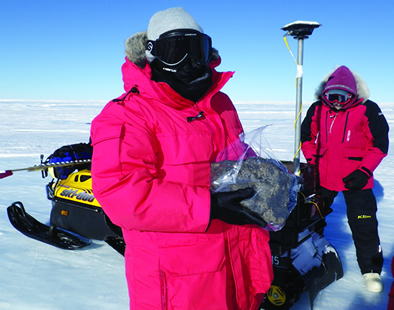
Other meteorites returned by ANSMET contain tiny grains of exceptionally hard and durable minerals such as silicon carbide and diamond. These grains existed before our sun began to shine, and thus are at least 4.6 billion years old.
"These grains were born in regions around previous generations of stars very different from the sun—red giant stars and carbon-rich stars—and were floating in space," Harvey explains. "Think of that: Some Antarctic meteorites actually contain bits of interstellar materials older than our solar system."
Antarctic meteorites are one of the best resources available to planetary geologists trying to get an idea of the range of materials in space. "Meteorite science today is where biology and zoology were in Darwin's time, " Harvey declares. "We're still at a stage where we are assembling a catalogue and seeing how specimens are related—and where major discoveries are still being made simply by finding another specimen."
So on tough days about the fourth week on the ice, if Harvey starts to grow weary of the harsh weather and long for a shower or home, he gazes across the wind-swept Antarctic glacier holding its cosmic treasure and reminds himself, "Likely no human being is going to see this landscape again after we leave." That thought, says Harvey, "truly changes my perspective on things."
Science journalist Trudy E. Bell is a Presidential Fellow, leading the SAGES seminar "Truth and Consequences: Science, Media, and Public Policy."





